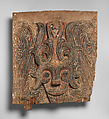Architectural Ornament
Not on view
This architectural panel is from a dwelling or rice barn of the Toba Batak people of northern Sumatra in Indonesia. The panel depicts the face of a singa, a composite animal which serves as a supernatural guardian, carved in high relief and painted in red, black, and white. The singa is shown with three horns with an outwardly curving horn on either side and a central horn that is bifurcated at the top to form a heart-shaped motif formed from two inward curving spirals, the tip of the proper left hand of which has been lost. The eyes are round and recessed beneath a prominent curving brow line in high relief that is continuous with the cheekbones and the nose, which has a blunt, rectangular tip. The mouth is carved in lower relief and has a prominent upper lip and protruding tongue, the extreme tip of which has been lost. The face is surrounded by a background of sinuous curvilinear motifs. An uncarved band of wood, which would have been concealed by the overlap of another architectural element when the piece was in situ, is visible at the top. The base of the panel is somewhat irregular in form, as a result of minor losses likely sustained when it was removed from the original structure and has a small squarish tab of wood that projects from the bottom of the plank beneath the proper right cheek of the singa image.
Due to rights restrictions, this image cannot be enlarged, viewed at full screen, or downloaded.

